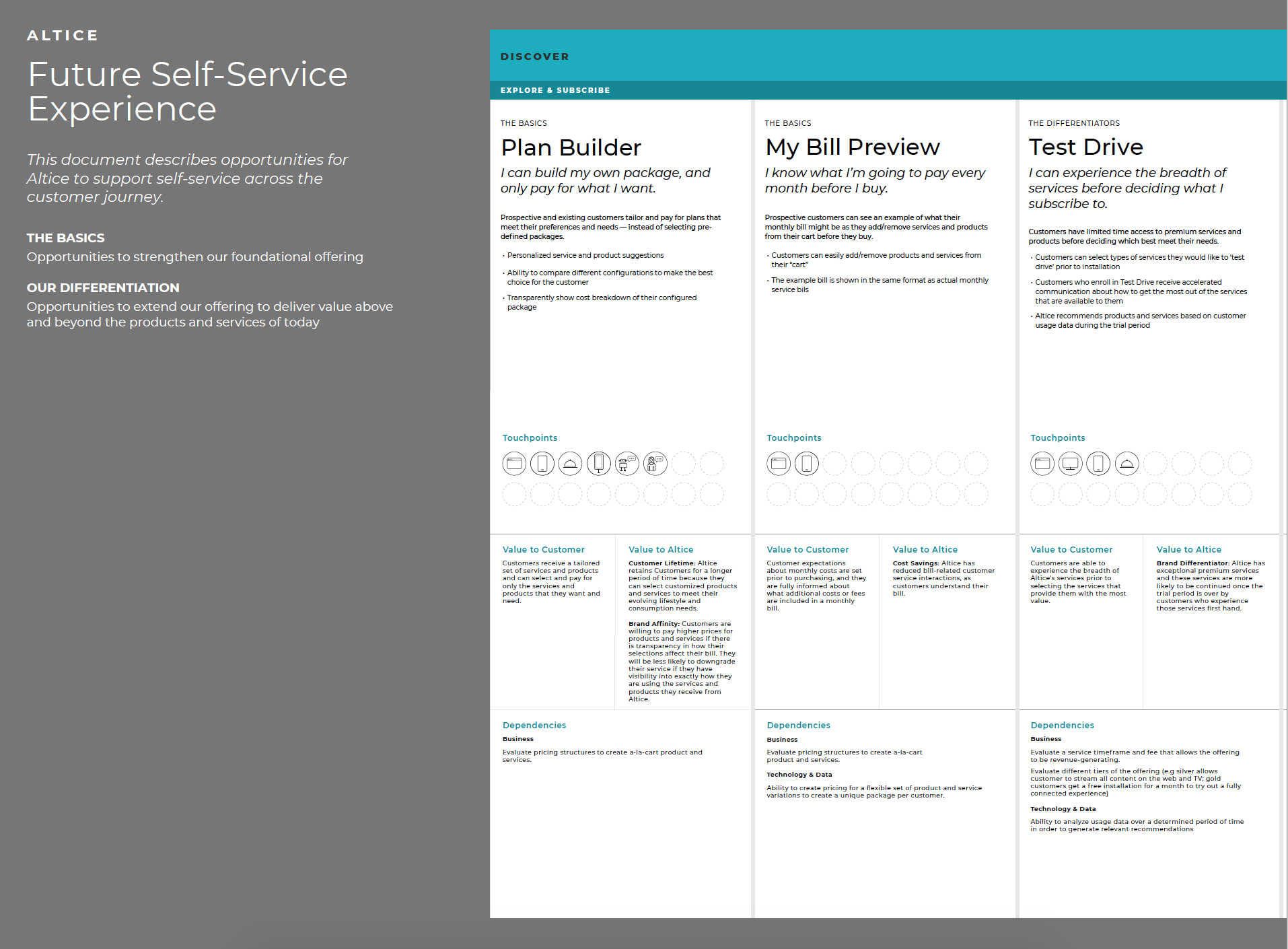
Altice USA
Paving the path toward digital transformation
Altice USA is the fourth largest internet, cable and phone provider in the U.S., providing high-quality service to nearly 5 million residential and SMB customers. But, with few easy-to-use self-service options available, customers are left to use high-cost customer service channels - like phone, chat and brick & mortar locations - to get help. Our team worked with Altice to define a customer support and self-service strategy — focusing on residential customers — to reduce reliance on high-cost customer service channels and improve perception of the Altice brand and service.
Project objectives | Create new self-service experiences in order to improve perception of the Altice brand, reduce reliance on high-cost customer service channels, identify opportunities for net-new revenue generation, and articulate a digital transformation strategy for the residential business.
Experience ambition | To deliver a unified service experience across our touchpoint so that customers feel better supported by and connected to the brand.
Project components | Consumer research; Journey mapping; Concept generation; Digital ecosystem strategy; Digital transformation strategy (consumer product organization); Capability building
Role | Director
Duration | 8 weeks
The experience that customers have with their telecom providers today is more contractual than it is human.
Connectivity is more important than ever — for work, personal connections and entertainment. While most of the time we don’t even think about our services, when we encounter changes to packages and bills, outages, and complicated installation account management processes, we experience a flash of frustration. So, we pick up the phone.
"No one loves their internet provider.”
It’s no surprise that customers experience frustration when trying to get information or assistance from their internet or cable provider. We conducted 1-on-1 interviews with Altice and competitor customers to understand their experiences when interacting with their service providers and seeking support. Our research showed that customers feel defensive during service interactions with Altice. Confusion around billing, changes in service and unexpected outages have contributed to customers feeling a lack of control over their relationship with the organization. Insights from this research revealed values that drive engagement today, and led to the creation of a set of experience principles that will guide all customer-facing experiences moving forward.
In addition, the experience design department within Altice was working towards bringing the voice of the customer into the decision-making of the broader organization. By conducting interviews with team members in Altice, and introducing new qualitative research methods, we helped build an arm of their research practice while gaining insight into their current customer experience.
Defining the Role of Customer Touchpoints
In order to envision a coordinated customer experience across touchpoints, we defined the roles and functions of each touchpoint. Through customer interviews and a review of current touchpoint engagement data, we gained a more complete picture of how, when, and why customers are engaging with digital, physical and human touchpoints.We then created a framework to describe the role that touchpoints can play in the context of customer support and self-service. This framework provided flexibility for Altice to consider which touchpoints should continue to be supported, which were redundant, and define the function of new touchpoints to be introduced in the future.
Empowering customers to manage their service on their terms through digital channels


Using existing business priorities, KPIs, market insights and findings from customer interviews, we identified pain points and opportunities to address them along the customer journey. These opportunities included both more efficient and effective ways to deliver existing services and support, to net-new revenue generating opportunities.
Paving the path for digital migration
Altice is a digital migrator — an organization that is moving toward digital transformation while contending with well-established roots in an increasingly inefficient operating model. While we can learn from organizations born of the digital age, transforming an organization that today relies on the physical cables that connect them with their customers requires careful consideration of the impact of each operational, business, cultural and technological shift.
Supporting the future-state experience goes beyond launching new features and functionality. Changing ways of working, and processes of launching and evaluating new experiences are not only needed, they are essential. Working with key stakeholders across Design/UX, CX, IT and Engineering, and Product, we articulated a strategic vision and roadmap for how the business, operations, and technology need to shift in order to deliver, maintain, and evaluate new experiences and offerings over time.
Introducing new tools, processes, and ways of working into the organization
Elevating the Customer Voice
Altice’s Customer Care department collects a lot of customer service interaction data. This information is available to groups across the organization but isn’t always used as an input for the design process. This engagement provided Altice team members with an opportunity to speak with their customers at the onset. We conducted interviews with customers in their homes to understand the challenges and perceptions that they have about their service and their relationship with the Altice brand today. Bringing the perspective of the customer into the design process gave Altice the opportunity to align customer needs with their business priorities.
Bridging the Gap Between Silos
Customer experiences that are disjointed often reflect the way that organizations operate internally. This engagement brought together groups from across the organization — including Design/UX, CX, IT and Engineering, and Product — to work in a collaborative environment. By bringing together stakeholders from across the organization, we were able to align on shared goals and quickly access expertise across the company towards a single objective.
Learning Through Collaboration
A core objective of collaboration was to work together with Altice as a single team. Through working sessions and co-location, we were able to include Altice stakeholders in customer interviews, quickly validate opportunities, and align on business objectives.
































